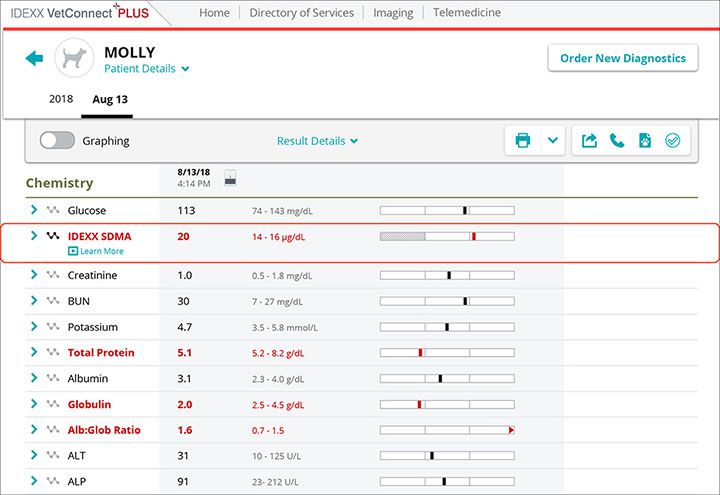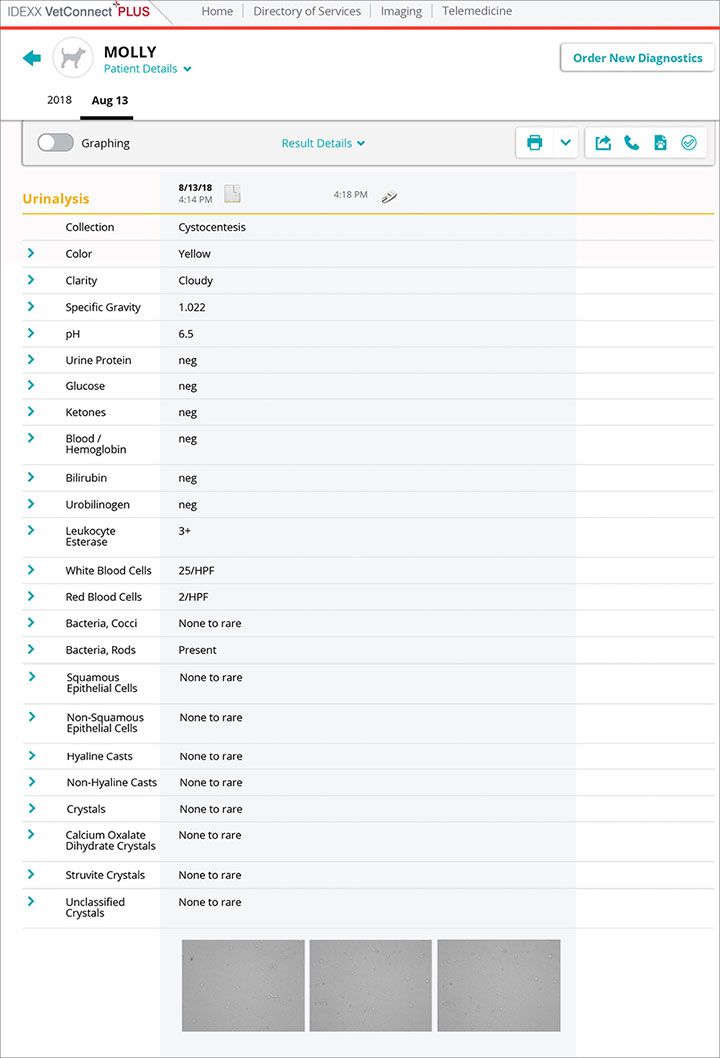IDEXX SDMA
SDMA Case Study: Molly
SDMA leads to diagnosis of active kidney injury in a puppy from preanesthetic blood work

Background information
Name: Molly
Age: 7 months
Breed: Shih tzu
Gender: Female
Presenting reason
Molly presented for a routine ovariohysterectomy.
History
Molly was purchased healthy from a breeder at 2 months of age. Molly’s diet consisted of Kirkland Signature puppy food and she reportedly had a good appetite. While Molly had occasional household accidents, Molly’s owners thought nothing of it, as they felt it might have been part of house training or just her excitable nature, and that it would improve with time.
Physical examination
Molly was bright, alert and responsive (BAR). She was well-hydrated and had a normal temperature, pulse and respiratory rate. Her body condition score (BCS) was excellent, and her weight was stable.
Diagnostic plan
Complete blood count (CBC); chemistry panel, including the IDEXX SDMA Test and electrolytes; the SNAP 4Dx Plus Test; and a complete urinalysis as a presurgical screen were recommended.
Laboratory findings
Molly’s presurgical diagnostic results showed a negative SNAP 4Dx Plus Test, a normal CBC, and the following chemistry findings.
Diagnostic review
- Increased SDMA* result guides us to investigate further – additional finding of low total protein as a result of low globulins is considered normal in puppies. The increased SDMA result was indicating an issue with kidney function.
- Next step considerations – a complete urinalysis should accompany an increase in SDMA. Additional diagnostics could include imaging of the kidneys as well.
- Status of Ovariohysterectomy appointment – further investigation of the laboratory results was recommended to rule out any conditions that could complicate Molly’s surgery.
Diagnostic review following SDMA signal to investigate further
- Molly’s complete urinalysis showed a urine specific gravity of 1.022, with white blood cells and rod-shaped bacteria on sediment evaluation. The urine was submitted to the reference laboratory for a urine culture and MIC (minimum inhibitory concentration) sensitivity.
- Diagnostic imaging can hold value for identifying and localising disease – Molly’s ultrasound showed both kidneys slightly decreased in size and mild bilateral renal pelvic dilation.
Patient reports
Chemistry

Urinalysis

Discussion
Molly’s single SDMA result led to the investigation and ultimate diagnosis of renal dysplasia and concurrent pyelonephritis. Antibiotic therapy based on the urine culture and MIC sensitivity findings proved valuable in getting the infection under control, and Molly’s urinalysis was normal at her 1-month follow-up appointment. Additionally, her SDMA returned to within normal limits at that recheck following treatment.
SDMA is more reliable than creatinine as a biomarker of kidney health,1–5 and elevations outside of normal limits should be investigated further for the underlying cause. For cases like Molly, it can identify a health situation that is treatable and establish a longer-term monitoring plan for blood work and urinalyses to guard against infections the patient can be predisposed to.
Why SDMA matters
Click the portraits to see how acting on IDEXX SDMA Test results helped Reese, Molly, Bess, Jimmy, Mary Jane, Scarlet and Zeke.
*Symmetric dimethylarginine.
References
- Nabity MB, Lees GE, Boggess M, et al. Symmetric dimethylarginine assay validation, stability and evaluation as a marker for early detection of chronic kidney disease in dogs. J Vet Intern Med. 2015;29(4):1036-1044.
- Hall JA, Yerramilli M, Obare E, Yerramilli M, Jewell DE. Comparison of serum concentrations of symmetric dimethylarginine and creatinine as kidney function biomarkers in cats with chronic kidney disease. J Vet Intern Med. 2014;28(6):1676-1683.
- Hall JA, Yerramilli M, Obare E, Yerramilli M, Almes K, Jewell DE. Serum concentrations of symmetric dimethylarginine and creatinine in dogs with naturally occurring chronic kidney disease. J Vet Intern Med. 2016;30(3):794-802.
- Hall JA, Yerramilli M, Obare E, Yerramilli M, Yu S, Jewell DE. Comparison of serum concentrations of symmetric dimethylarginine and creatinine as kidney function biomarkers in healthy geriatric cats fed reduced-protein foods enriched with fish oil, L-carnitine and medium-chain triglycerides. Vet J. 2014;202(3):588-596.
- Hall JA, Yerramilli M, Obare E, Yerramilli M, Melendez LD, Jewell DE. Relationship between lean body mass and serum renal biomarkers in healthy dogs. J Vet Intern Med. 2015;29(3):808-814.



